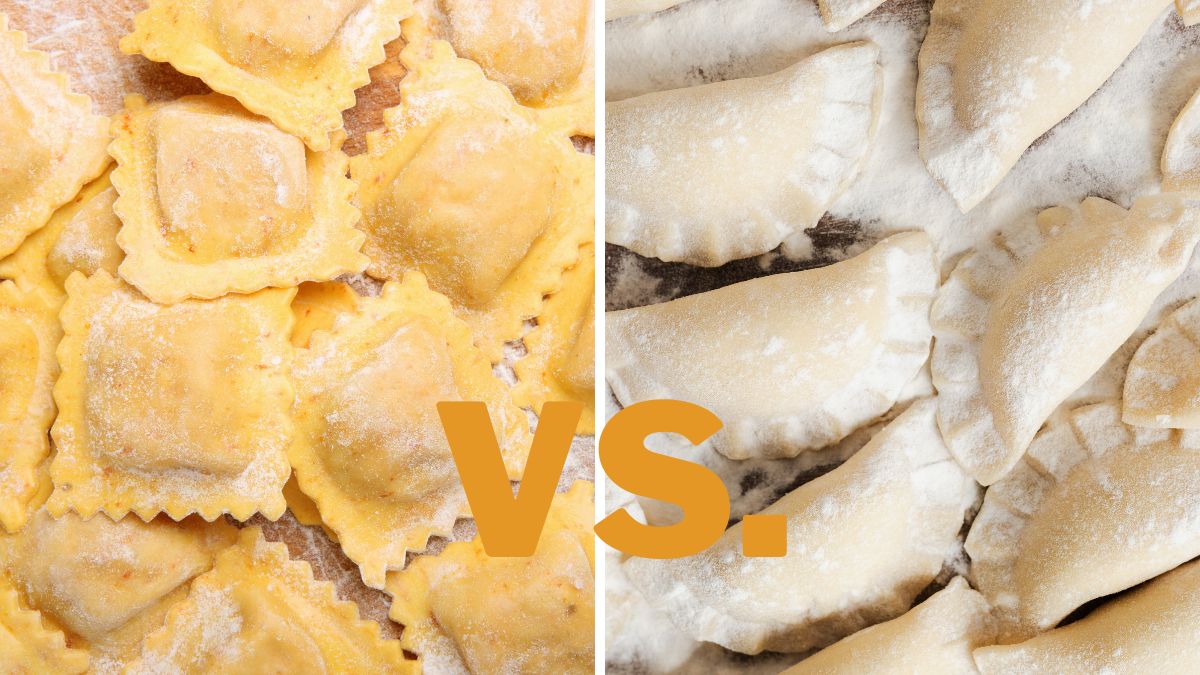Ravioli vs. Pierogi: Differences & Uses

Even though I am more used to ravioli, I have recently started exploring all similar pasta types — this is how I came across pierogi. Similar in shape and made out of similar ingredients, ravioli and pierogi are two similar pasta delicacies, but they are most certainly not the same. They are close and distant cousins at the same time, sharing the same ancestry, but having developed in different directions. So, what are the differences between pierogi and ravioli?
Pierogi are Eastern European, while ravioli are Italian. They use the same dough but contain different fillings and are differently cooked. The traditional ravioli filling is ricotta cheese, and pierogi are filled with potatoes. Both come in many variations.
Both ravioli and pierogi are delicious, but they are different in taste and texture. Some love them both, but others are more inclined towards one or the other. Therefore, in the following paragraphs, I will explain the differences between ravioli and pierogi. Knowing the differences between pierogi and ravioli will make you a bit smarter when preparing them for your guests. So, let’s dive in!
Appearance
Even though they seem similar, their appearances still give them out, so it is virtually impossible to mistake pierogi for ravioli and vice versa. Ravioli is Italian square-shaped pasta pieces with a circle-shaped filling bump in the middle.
Pierogi is the Eastern European cousin of ravioli, given that they have the same base dough. It’s a half-moon-shaped type of pasta, and very similar to panzerotti both in shape and texture. You may as well call it the Eastern European version of panzerotti.
In terms of size, pierogi is slightly larger than ravioli. It’s considered finger food, as opposed to ravioli, which is more of an ingredient than a dish in itself.
Ravioli is soft and smooth to the touch with a visibly gentle texture and a light beige color. Pierogi has a rougher texture and is golden brown in color.

Dough
Pierogi and ravioli use the same dough, i.e., a mixture of flour, eggs, and water. They are initially made the same way, so you can further use the same dough for both.
Still, this doesn’t mean that these two pasta kinds taste completely the same. What further makes them different are the filling and the cooking method. So, if you think the two are the same, wait for it!
Filling
You could say that ravioli is the fancier of the two, and pierogi is the more rustic one. The traditional filling for ravioli is ricotta cheese, but it’s often filled with other cheeses, meat, vegetables, spinach, or mushrooms.
On the other hand, pierogi is traditionally filled with potatoes, but there are variations filled with sauerkraut, brined vegetables, or cooked fruit.
Basically, both pierogi and ravioli are a sheer depiction of the cultures from which they come and what is most available and abundant in those regions. Italy is known for its delightful cheeses, and Eastern Europe is famous for its potatoes and vegetables, as well as its preservation methods.
They are both delicious and authentic but selflessly give themselves to the world. Therefore, you can find many variations of both, depending on where they are made. If you’re making them yourself, you can of course put anything you want inside — and although I’m all for experimentation, I haven’t yet gotten a chance to properly explore all the possible filling ideas, but I’m really looking forward to it!
Taste
Since they use very different fillings and are cooked differently, these two types of pasta taste very different, and there is no chance you will mix them up.
Potato pierogi tastes somewhat bland due to the neutral potato flavor. Therefore, it requires a flavor-giving addition, such as a sauce or a dish, to spice things up. Sauerkraut or brined vegetables versions are zingy, sour, salty, and tangy.
Mostly, ravioli is cheesy, as it’s most frequently filled with cheese. Ravioli gets its taste from the filling, so whatever you fill it with, it will taste like that. The dough itself is a standard pasta dough, so it tastes like plain pasta.
The pierogi dough definitely has more flavor, even without the filling. I’ve recently become an avid fan of it and I must say, I kind of like it more than ravioli.
Cooking Method
Pierogi and ravioli start the same but develop in different directions. While they use the same base ingredients, they finish differently. After being stuffed, ravioli are boiled, while pierogi are fried.
This results in entirely different dishes. If you weren’t convinced until now, you can see that the two are completely different! Due to the different cooking methods, ravioli and pierogi differ in their further uses.
Uses
While ravioli is more of an ingredient that needs further work, pierogi are finger foods and are often eaten as they are. You can nibble on pierogi, but ravioli need sauce, a salad, or some kind of broth or soup which they can feature in.
Pierogi are also combined with sauces, but they are not served inside the sauce, like ravioli, but are dipped in sauce, like panzerotti. Anyways, both are delicious in their own regards, but they are made with completely different purposes.
